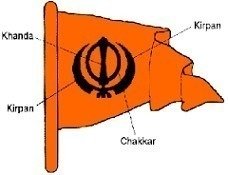IkOankar can be realized by anyone and Nishan Sahib guides the path
IkOankar (1-Force) is the nucleus of the Sikh worldview, but Sikh values do not restrict access to members of the faith only. IkOankar can be realized by anyone who is willing to discover Infinite Wisdom through love. In the light of the events unfolding in Delhi and the narrative relating to Nishan Sahib, the US-based Sikh Research Institute underlines the significance of the Nishan Sahib and the Chakkar inside the insignia –Khanda.
![IkOankar (1-Force) is the nucleus of the Sikh worldview, but Sikh values do not restrict access to members of the faith only. IkOankar can be realized by anyone who is willing to discover Infinite Wisdom through love. In the light of the events unfolding in Delhi and the narrative relating to Nishan Sahib, the US-based Sikh Research Institute underlines the significance of the Nishan Sahib and the Chakkar inside the insignia –Khanda. SIKH PRINCIPLES command practice that is dedicated to […]](https://www.theworldsikhnews.com/wp-content/uploads/2021/02/Boy_Nishan1-360x240.jpg)
SIKH PRINCIPLES command practice that is dedicated to securing a pluralistic society in which all people can thrive. As such, the only concrete “ban” in the Sikh worldview is any practice or governance that is oppressive or prioritizes the freedom of some over others.
Sikhs strive to follow a path that is divine-oriented and principle-based; a lifestyle that is humble and disciplined, and ever-ready to combat injustice through organized resistance.
The Khanda emblem adorns Nishan Sahib—the Sikh flag—and captures the Sikh worldview. The design of the Khanda incorporates four weapons that were used in Sikh history.
 In Sikhi, a balanced life involves a harmony of the outer life, called Miri (political sovereignty), and the inner life, called Piri (spiritual sovereignty). Miri and Piri are represented by the two swords on the outer edge of the design. The double-edged sword in the centre, also called a Khanda, represents the passage one takes through life as illustrated by the ten founding Gurus of Sikhi.
In Sikhi, a balanced life involves a harmony of the outer life, called Miri (political sovereignty), and the inner life, called Piri (spiritual sovereignty). Miri and Piri are represented by the two swords on the outer edge of the design. The double-edged sword in the centre, also called a Khanda, represents the passage one takes through life as illustrated by the ten founding Gurus of Sikhi.
 The circular throwing disc, known as a Chakkar, represents the all-embracing and all-encompassing nature of IkOankar. Taken as a whole, the Khanda represents the creative, sovereign power of IkOankar, the force that governs the universe in its entirety.
The circular throwing disc, known as a Chakkar, represents the all-embracing and all-encompassing nature of IkOankar. Taken as a whole, the Khanda represents the creative, sovereign power of IkOankar, the force that governs the universe in its entirety.
May the Wisdom-Guru be with us.
Nishan Sahib Image courtesy: www.sikhmuseum.com
